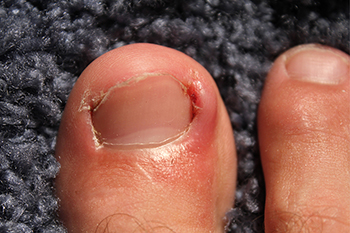
An ingrown toenail, or onychocryptosis, affects people of all ages, disrupting daily activities. It occurs when the nail, due to its natural shape or improper care, grows into the surrounding skin, causing inflammation and potential infection. The nail's growth pattern, influenced by its originating area called the nail matrix, plays a significant role. Specifically, curved or wide nails increase the risk of ingrowths. Other causes can include improper nail trimming, wearing tight shoes, nail picking, and foot injuries. It can progress to an infection if symptoms include redness or warmth, and the presence of pus. If you have an ingrown toenail, it is suggested that you schedule an appointment with a chiropodist who can guide you toward correct treatment methods which can help to restore comfort.
Ingrown toenails may require medical attention. If you have significant pain or notice signs of infection from an ingrown toenail, please consult with Chiropodist Stephanie Poupore from North Bay Foot & Ankle. Our clinician will assess your condition and provide you with quality foot and ankle treatment.
What Is an Ingrown Toenail?
An ingrown toenail occurs when the edges of a toenail grow into the surrounding skin. The toenails of the big toe are usually affected, however, an ingrown toenail can happen on any toe. Sometimes, the area can become infected leading to potentially serious complications. The ingrown toenail may be caused by improper trimming of the toenail, wearing ill-fitting shoes, or injury to the nail.
Symptoms
The symptoms of an ingrown toenail include:
Pain
Swelling
Redness
Warmth
Pus or drainage from the affected nail or a fever may indicate an infection of the area.
Treatment
Treatment depends on the severity of the ingrown toenail. In less severe cases, home treatment may be adequate. Soaking the affected foot in warm water and gently lifting the nail from the skin with a piece of clean cotton can help. In more severe cases, you may need to use topical or oral antibiotics to treat an infection. Surgical removal of the ingrown toenail may be required if more conservative treatments fail.
Ingrown toenails may be prevented by wearing well-fitted shoes and properly trimming the toenails. Toenails should be trimmed straight across and not too short when using nail clippers.
If you have any questions, please feel free to contact our office located in . We offer the newest diagnostic and treatment technologies for all your foot care needs.
